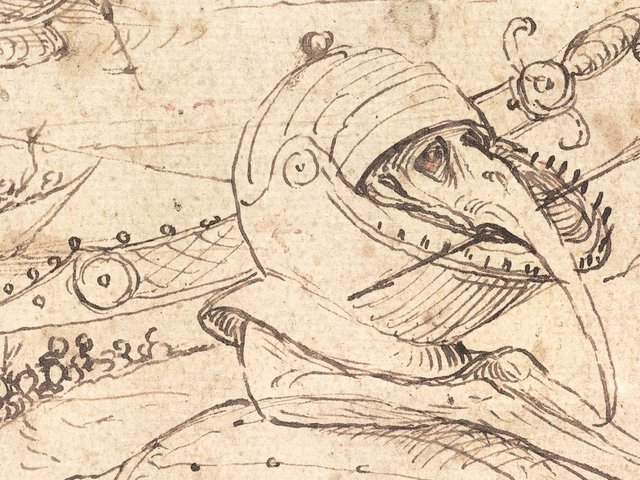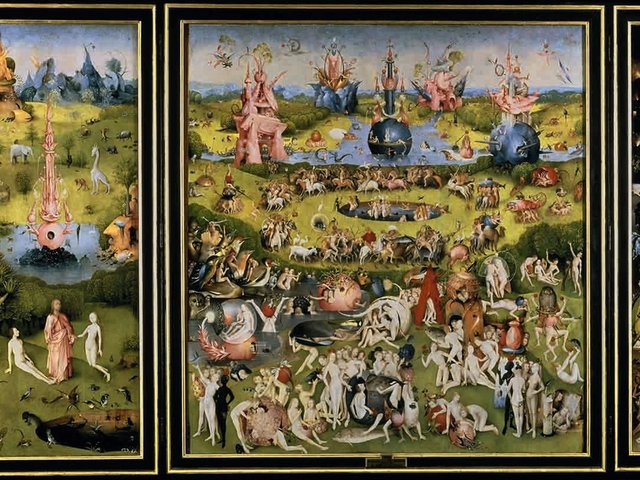No more than 25 paintings and a similar number of drawings can be reliably attributed to the Netherlandish artist known as Hieronymus Bosch, who lived from around 1450 to 1516. Yet his images inspired countless imitators and continue to haunt the Western imagination today. His “fantastic and capricious inventions”, as the Italian commentator Giorgio Vasari described them in the 16th century—his monstrous animals and plants, his compelling visualisations of human sinfulness—were without precedent in the history of European art. Bosch’s work has been commodified. It is difficult, in an age in which the Garden of Earthly Delights is available as a virtual reality app, and a selection of Bosch’s most extraordinary creatures can be purchased online as modestly priced figurines, to recapture the original impact of his paintings and to understand their significance for their late-medieval viewers. “Boschian” has become shorthand for weird fantasy, and the artist’s name is synonymous with the depiction of Freudian nightmares. Yet as all of the works under review here emphasise, Bosch was a respected figure in his local community—an elite member of the most prestigious religious confraternity in his home town of ’s-Hertogenbosch—and his idiosyncratic art attracted plenty of wealthy patrons and admirers, both during and after his lifetime.
Last year was the quincentennial anniversary of Bosch’s death. Two exhibitions, one at the Noordbrabants Museum in ’s-Hertogenbosch and the other at the Museo Nacional del Prado in Madrid, attracted between them more than a million visitors. The exhibitions brought together an unprecedented number of Bosch’s works. These very public celebrations were accompanied by a huge amount of new scholarship and a fair dose of controversy. From 2010 to 2016 a team of mostly Dutch scholars and scientists undertook a thorough investigation of around 50 paintings and drawings attributed to Bosch, spread across 25 museum collections in ten different countries. This monumental enterprise, the Bosch Research and Conservation Project (BRCP), has resulted in an unprecedented expansion of our knowledge about the artist and his workshop. Heated discussion ensued, however, when the team concluded that four Spanish-owned works formerly attributed to Bosch should, in fact, be demoted to the status of “workshop” or “follower”.
As the Bosch quincentenary, with its festivities and fights, recedes, we are left with a wealth of new publications. They include two separate exhibition catalogues, Hieronymus Bosch: Visions of Genius and Bosch: the 5th Centenary Exhibition; the stunning Hieronymus Bosch, Painter and Draughtsman: Catalogue Raisonné and Hieronymus Bosch, Painter and Draughtsman: Technical Studies, based on the work undertaken by the BRCP; and Joseph Koerner’s much-anticipated Bosch and Bruegel: from Enemy Painting to Everyday Life, which began as a series of lectures delivered at the National Gallery of Art in Washington, DC, in 2007. There are also a number of smaller accounts of Bosch’s life and work aimed at a broad audience.
Where to start? The exhibition catalogues perhaps offer the easiest entry point for the engaged lay reader. Hieronymus Bosch: Visions of Genius, which accompanied the Dutch exhibition, provides an accessible summary of the results of the BRCP’s Herculean toil. Six sections examine the approximately 50 images, providing brief, easily digestible accounts and interpretations of each—no mean feat, given the cryptic nature of many of Bosch’s iconographies. The authors highlight predictable themes: Bosch’s fixation on earthly possessions and pleasures, on the seductiveness of evil, and on eschatology. They also offer a glimpse into the substantial technical analysis undertaken by the BRCP through dendrochronology, infrared reflectography and X-ray photography, and into the questions of attribution and workshop collaboration that lay at the heart of the team’s investigations. The catalogue is lavishly illustrated, with stunning details that are essential to any study of Bosch’s work. For those who want more, the 600-page Catalogue Raisonné and 450-page Technical Studies record, between them, everything BRCP did during its analysis. The two volumes allow a thorough evaluation of Bosch’s materials and techniques, provide a detailed conservation history of his entire oeuvre, and offer technical accounts of every individual work. Thanks to wonderful photographs of underdrawings and of paint application, the reader is able to step deep inside each image. The Prado catalogue, Bosch: the 5th Centenary Exhibition, provides an excellent self-contained introduction to the artist and his work. It opens with a series of essays covering themes such as the sources for Bosch’s art, his depictions of hell, and the reception of his works in the 16th century. Its introduction, written by the exhibition’s designer, Pilar Silva Maroto, testifies to the rivalries that 2016 engendered. Maroto emphasises Bosch’s Spanish history: so many of the artist’s works ended up in Castile, thanks largely to Philip II’s penchant for them, that the Flemish commentator Karel van Mander wrongly assumed in 1604 that Bosch had spent part of his career there. The Prado is described as the “home of Bosch”, and The Garden of Earthly Delights (1503-15) as the “crown jewel” of its wonderful collection of early Netherlandish painting.
At the intellectual heart of this feast of Bosch scholarship lies, without doubt, Koerner’s new study, Bosch and Bruegel: from Enemy Painting to Everyday Life. Here scientific analysis and questions of attribution give way to an erudite and deeply engaging exploration of Bosch, Pieter Bruegel (around 1525-69) and rise of “secular painting”. The visual parallels between the two artists are, as 16th-century observers were well aware, manifold: both exercised fantasy, both were drawn to the depiction of ordinary life, and both constructed vast visual planes—endless spaces brimming with detail. Bosch and Bruegel, Koerner writes, “captivate and overload our sense of sight … ensnaring the mind’s eye in enigmas and seeming secrets”. Yet the two artists were separated by a great historical divide: Bosch belongs firmly to the Christian Middle Ages, whereas when we encounter Bruegel, with his landscapes and scenes of peasant life, “the ground slopes forward to Modern art and the secular condition”. Bruegel’s works are all, Koerner argues, works of art.
Koerner offers, here, a contribution to long-standing debates about art’s shift, during the Renaissance, from the religious to the aesthetic sphere. The origins of genre painting can be found, he suggests, in Bosch’s images, with their dramatisation of human existence and their privileging of everyday experience. This is, however, “enemy painting”: amid Bosch’s human actors and real-world settings, the devil always lurks. In Bosch’s images the familiar, the quotidian, is hostile territory, waiting to entrap those who succumb to its temptations.
Neither Bosch’s nor Bruegel’s images can be understood without due attention to sources and symbolism, as Koerner acknowledges. His real interest, however, is less in what the images mean than in how they function: drawing the viewer in, entrapping them, and awakening particular responses. Bosch, Koerner argues, makes the beholder the subject of the painting’s gaze, requiring him to reflect on the folly of human existence: on carnal desire, on avarice, and on the imminence of the apocalypse. In a passage that elucidates these images better than any detailed iconographical study possibly could, Koerner invokes the 1998 film The Truman Show: what if your entire world were make- believe? What if, for your whole lifetime, you were unknowingly the inmate of a huge prison, where you were being constantly and secretly watched? This, he suggests, is the hypothesis that underlies Bosch’s works, which immerse viewers in deception and false testimony, placing them in a world of illusion where nothing is as it seems.
Koerner’s mastery not only of the images themselves but of their historical context emerges in his discussions of Bosch’s patrons, and of the religious, social and political currents that fed into his paintings and drawings. He explains the individual elements of each image not in reductionist terms, as expressions of crude symbolism, but as reflections of the broader preoccupations of the age, from sodomy and anti-Semitism to princely collecting and the rise of the Wunderkammer, or cabinet of curiosities. He brings a huge variety of interpretative methods to bear on the images, revelling in their complexity and ambiguity. There are places where he wears his learning less than lightly, where those less comfortable with literary theory and psychoanalysis may feel just a little lost. But he has the ability to present familiar works—often pinned in reproduction to the walls of student dorms—in ways that send shivers down the spine. No reader could fail to be captivated, for example, by Koerner’s accounts of Bruegel’s landscapes and of the biblical paintings that visualise the 16th-century world’s indifference to Christ’s suffering and sacrifice. Koerner’s study of Albrecht Dürer and Hans Baldung Grien, The Moment of Self-Portraiture in German Renaissance Art (1993), echoes through the work, informing his analysis of the Netherlandish images’ engagement with their viewers and of their creators’ interest in self-representation.
Where, then, has the quincentenary left us? What will be 2016’s lasting legacy for Bosch scholarship? First, a wealth of new technical knowledge, made easily accessible through the publications of the BRCP. Second, in interpretative terms, the final demise of delusional scholarship: of studies that link Bosch to heretical groups such as the Adamites and Cathars, or that continue the futile quest for a single interpretative key that will unlock all his works. There are, as the Prado catalogue baldly puts it, no “unambiguous external sources determining Bosch’s imagery”. All of this recent literature pays proper attention to the creative genius of the artist himself, but much of it also considers the associative and imaginative powers of his original audiences, the memories and preoccupations that shaped their experiences of his idiosyncratic art. Finally, we must consider not only what these images meant but also how they worked: Bosch’s paintings and drawings admonish their viewers, holding up a mirror to the world and its follies. They seduce the beholder, drawing him in and serving, in Koerner’s words, as “pride-seeking missiles” targeted on the sins of greed and lust. Bosch was a shrewd observer and a skilled documenter of human nature: he alone among his contemporaries had, as Joseph de Sigüenza, Philip II’s librarian at the Escorial, noted, the audacity to “paint man as he is on the inside”. It is surely this, as much as his monsters and chimeras, that has determined his lasting appeal.
• Bridget Heal is the director of the Reformation Studies Institute at the University of St Andrews. She is the author of The Cult of the Virgin Mary in Early Modern Germany (2007) and of the forthcoming A Magnificent Faith: Art and Identity in Lutheran Germany
Hieronymus Bosch: Visions of Genius
Matthijs Ilsink and Jos Koldeweij Y
ale University Press, 192pp, £20, $35 (pb)
Hieronymus Bosch, Painter and Draughtsman: Catalogue Raisonné
Matthijs Ilsink, Jos Koldeweij, Ron Spronk, Luuk Hoogstede et al
Yale University Press, 608pp, £100, $150 (hb)
Hieronymus Bosch, Painter and Draughtsman: Technical Studies
Luuk Hoogstede, Ron Spronk, Matthijs Ilsink, Jos Koldeweij et al
Yale University Press, 464pp, £85, $150 (hb)
Bosch: the 5th Centenary Exhibition
Pilar Silva Maroto, ed
Thames and Hudson in association with Museo Nacional del Prado, 400pp, £29.95 (pb)
Bosch and Bruegel: from Enemy Painting to Everyday Life
Joseph Leo Koerner
Princeton University Press, 448pp, £54.95, $65 (hb)



